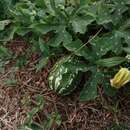Brief Summary
provided by EOL authors
Cucurbita mixta, which encompasses various cultivars of pumpkin and winter squash (sometimes known as cushaw or pipian or calabaza), is a plant species in the gourd family (Cucurbitaceae) likely native to North America and cultivated by indigenous peoples before the arrival of Europeans. It is now cultivated in warm areas around the world as food and animal fodder and for the seeds. Related cultivated species also known as winter squash or pumpkins are C. maxima and C. moschata; C. pepo cultivars have also been called winter squash and pumpkins, but are more commonly known as summer squash. It can be difficult to ascertain which varieties are derived from which species, because the names “winter squash” and “pumpkin” are used to refer to several different species, and those species may also have other common names. Seed catalogs often omit genus and species names, so many cultivars are sold without a clear indication of which species they are derived from. C. mixta is the source of many varieties of pumpkins commonly grown in the U.S., particularly in the Southeast. They are preferred for their adaptation to warm climates and their resistance to insect pests. Although C. maxima is the species that produces giant pumpkin cultivars (those that produce fruits weighing over 45 kg [100 pounds]), and C. moschata is the source of much canned pumpkin in the U.S., C. mixta includes cultivars favored for their flavor for pies. The C. mixta pumpkin is the state fruit of New Hampshire. C. mixta plants are frost-intolerant herbaceous annuals. Their soft hairy stems are generally trailing or climbing vines. Leaves are large, simple, alternate, and shallowly to moderately lobed. The peduncle (stem that holds the fruit) is hard and five-angled, and the enlarged end where it attaches to the fruit develops warty cork tissue. Fruits (technically referred to as pepos) are relatively large. Seeds, which are 17–40 mm long, separate easily and cleanly from the pulp. Winter squashes and pumpkins are eaten as a vegetable, mashed or in purees, soups, or pies. Seeds are high in protein, oil, minerals (they contain 30% protein and 40–50% oil), and are eaten raw, toasted, or pressed to make oil. In South and Central America, seeds of related Cucurbita species are toasted and eaten to kill worms and other intestinal parasites. Pumpkin seeds are sometimes used as a natural worming agent for sheep and goats by organic farmers, but their efficacy has not been clearly demonstrated. World production of pumpkins, squashes, and gourds (across all species of Cucurbitaceae) was 22.1 million tons harvested from 1.7 million hectares in 2009, valued at $5.2 billion U.S. dollars. Leading producers were China, Russia, India, the U.S., and Egypt. (Ecocrop 2011, New Hampshire Almanac 2011, Schoenian 2011, Schultes 1990, Whittaker and Davis 1962, Wikipedia 2011)
- license
- cc-by-nc
- copyright
- Jacqueline Courteau

